Guide E-307
Nancy C. Flores and Cindy Schlenker Davies
College of Agricultural, Consumer and Environmental Sciences, New Mexico State University
Authors: Respectively, Extension Food Technology Specialist, Department of Extension Family and Consumer Sciences; and County Program Director/Extension Home Economist, Bernalillo County Extension Office, New Mexico State University. (Print friendly PDF)
Publication currently being updated. Will become available by Dec 2025. If you need assistance on this topic, find some resources below:
-
Colorado State University Extension - Canning Vegetables
-
Email or call: pubs@nmsu.edu | (575) 646-1174
| Caution: This publication is intended for individuals with a basic understanding of canning procedures. For more detailed information, consult the USDA Complete Guide to Home Canning (2009), which is available online at https://nchfp.uga.edu/publications/publications_usda.html or through your local county Extension office (https://aces.nmsu.edu/county/). |
Because vegetables are naturally low in acid, canning them requires special precautions that differ from those for canning high-acid foods. In particular, canning procedures must prevent the growth of microorganisms. Some bacteria cause food spoilage, while others produce toxins that cause illness or death. For example, Clostridium botulinum is a harmless bacterium in air. However, in the environment inside a canning jar with little or no acid (pH greater than 4.6), no oxygen, and temperatures between 40 and 120°F, this bacteria grows and produces a deadly toxin that can cause serious damage to the central nervous system or death when eaten in very small amounts (botulism).
Pressure processing is the only safe way to can vegetables without adding any acid. Boiling water produces steam. The temperature of steam under pressure is much higher than it normally would be without pressure. To prevent botulism, the internal temperature of canned vegetables and other non-acid foods must reach 240°F. This guide provides the correct processing times and canner pressures for canning vegetables safely in New Mexico.
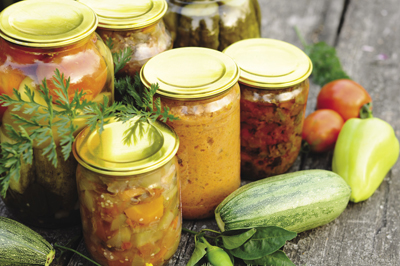
(© Olgavolodina | Dreamstime.com)
To prevent the risk of botulism, low-acid and tomato foods not canned according to the USDA recommendations in this guide should be boiled even if no signs of spoilage are detected. Boil canned food for a full 10 minutes at elevations below 1,000 feet; add an additional minute of boiling time for each 1,000 of feet elevation (Table 1). Boiling destroys botulin toxin. If in doubt, always boil foods before tasting.
|
Table 1. Boiling Times for Canned Food to Destroy Botulin Toxin |
|
|
At elevation (ft) |
Boil foods (minutes) |
|
2,000–2,999 |
12 |
|
3,000–3,999 |
13 |
|
4,000–4,999 |
14 |
|
5,000–5,999 |
15 |
|
6,000–6,999 |
16 |
|
7,000–7,999 |
17 |
|
8,000–8,999 |
18 |
|
9,000–9,999 |
19 |
Canning Equipment List
Cutting board
Knife
Peeler/corer
Mixing spoons
Tongs
Measuring cup and spoon sets
Canning jars
Canning lids and screw bands
Re-sealable plastic bags for leftovers
Pot holders × 2
Paper towels
Cloth towels × 2
Dish soap and scrubber
Cooking pots in 1-quart and 5-quart sizes
Large strainer
Mixing bowl set in 2-, 3-, and 5-quart sizes
Canning set
Pressure canner with rack for proper elevation
Selecting Vegetables
Select freshly harvested, tender vegetables that are free of bruises, blemishes, or signs of disease or decay. To avoid waste, prepare only enough vegetables that will fill the number of jars that can fit into the canner. See Table 2 for recommended quantities of food.
The following vegetables are not recommended for home canning: broccoli, Brussels sprouts, cabbage, cauliflower, kohlrabi, rutabaga, squash, wild mushrooms, mashed potatoes, pumpkin purée, sweet potatoes (chunk size only), and red chile.
|
Table 2. Estimated Amounts (in pounds) of Vegetables Necessary for a Pressure Canner Load |
||
|
Vegetable |
Canner load |
|
|
9 pints |
7 quarts |
|
|
Pounds of vegetables |
||
|
Asparagus |
16 |
24 1/2 |
|
Beans or peas (shelled or dried) |
3 1/4 |
5 |
|
Beans (green) |
9 |
14 |
|
Beets (without tops) |
13 1/2 |
21 |
|
Carrots |
11 |
17 1/2 |
|
Corn (cream style) |
20 |
* |
|
Corn (whole kernel) |
20 |
31 1/2 |
|
Lima beans (fresh) |
18 |
28 |
|
Mushrooms |
7 1/2a |
14 1/2b |
|
Okra |
7 |
11 |
|
Peas (green, English, or shelled) |
20 |
31 1/2 |
|
Peppers (hot or sweet) |
9 |
* |
|
Potatoes |
22 1/2 |
35 |
|
Pumpkin (1-inch chunks) |
10 |
16 |
|
Spinach and other greens |
18 |
28 |
|
Sweet potatoes |
11 |
17 1/2 |
|
a Makes 9 half-pints b Makes 9 pints * Not recommended |
||
Salt
If desired, add 1/2 teaspoon of salt per pint or 1 teaspoon per quart. Salt may be omitted since it is used only for flavor. For best results, do not use salt substitutes for canning since heat causes some substitutes to become bitter or develop a metallic taste. Instead, add salt substitutes just before serving.
General Canning Procedures
Use regular or wide-mouth Mason jars with self-sealing lids held in place by screw-on metal bands. The bands hold the lids in place during the processing and cooling periods, and can be removed and reused after cooling. Mason jars are made from tempered glass to resist high temperatures. Jars are available in 1/2 pint, pint, 1 1/2 pint, and quart sizes. Larger jars are not recommended for home canning. Do not reuse glass jars or bottles from commercially processed products such as mayonnaise because these jars will not withstand the water bath or pressure canner heating process.
Inspect jars carefully for cracks or chips and discard faulty ones. Wash jars in hot, soapy water and rinse thoroughly or clean using a dishwasher. To sterilize jars, keep jars hot in the dishwasher, a sink of hot water, or in a warm 180°F oven until they are filled. Check metal screw bands for signs of rust or dents. Discard corroded or dented bands. Use only new lids and follow the manufacturer’s directions for preparing lids for canning. Do not use lids that are missing any gasket compound, dented, deformed, or older than five years from date of manufacture.
Vegetables may be hot or cold when packed into jars. However, blanching for 3–5 minutes forces air from vegetables, resulting in better color and more space for food in the jar. Pack food loosely and add hot liquid, usually water. Leave a 1-inch headspace. Slip a rubber or plastic spatula between the food and the jar to help release trapped air bubbles. Use a clean, damp cloth or paper towel to wipe the rim and threads of each jar. Put on a new lid with a screw-on metal band to hold it in place; tighten comfortably. See Figure 1 illustrating these steps for jar filling. Process using a pressure canner.
“Follow these steps for successful pressure canning:
-
Put 2 to 3 inches of hot water in the canner. [In areas with hard water, add 1 tablespoon of vinegar to reduce mineral deposits on jars.] Some specific products in this Guide require that you start with even more water in the canner. Always follow the directions with USDA processes for specific foods if they require more water added to the canner. Place filled jars on the rack, using a jar lifter. When using a jar lifter, make sure it is securely positioned below the neck of the jar (below the screw band of the lid). Keep the jar upright at all times. Tilting the jar could cause food to spill into the sealing area of the lid. Fasten canner lid securely.
-
Leave weight off vent port or open petcock. Heat at the highest setting until steam flows freely from the open petcock or vent port.
-
While maintaining the high heat setting, let the steam flow (exhaust) continuously for 10 minutes, and then place the weight on the vent port or close the petcock. The canner will pressurize during the next 3 to 5 minutes.
-
Start timing the process when the pressure reading on the dial gauge indicates that the recommended pressure has been reached, or when the weighted gauge begins to jiggle or rock as the canner manufacturer describes.
-
Regulate heat under the canner to maintain a steady pressure at or slightly above the correct gauge pressure. Quick and large pressure variations during processing may cause unnecessary liquid losses from jars. Follow the canner manufacturer’s directions for how a weighted gauge should indicate it is maintaining the desired pressure.
IMPORTANT: If at any time pressure goes below the recommended amount, bring the canner back to pressure and begin the timing of the process over, from the beginning (using the total original process time). This is important for the safety of the food. -
When the timed process is completed, turn off the heat, remove the canner from heat if possible, and let the canner depressurize. Do not force-cool the canner. Forced cooling may result in unsafe food or food spoilage. Cooling the canner with cold running water or opening the vent port before the canner is fully depressurized will cause loss of liquid from jars and seal failures. Force-cooling may also warp the canner lid of older model canners, causing steam leaks. Depressurization of older models without dial gauges should be timed. Standard-size heavy-walled canners require about 30 minutes when loaded with pints and 45 minutes with quarts. Newer thin-walled canners cool more rapidly and are equipped with vent locks. These canners are depressurized when their vent lock piston drops to a normal position.
-
After the canner is depressurized, remove the weight from the vent port or open the petcock. Wait 10 minutes, unfasten the lid, and remove it carefully. Lift the lid away from you so that the steam does not burn your face.
-
Remove jars with a jar lifter, and place them on a towel, leaving at least 1-inch spaces between the jars during cooling. Let jars sit undisturbed to cool at room temperature for 12 to 24 hours.” (pp. I-21–22, USDA [2009])
Do not touch jars, lids, or rings until they are completely cooled.
-
Dial gauges on pressure canners should be checked annually to make sure they are accurate.
-
Weighted gauges on pressure canners are not accurate for elevations above 10,000 feet. Follow manufacturer instructions for proper use.
-
Rubber gasket must be pliable and in good condition to maintain seal of pressure canner.
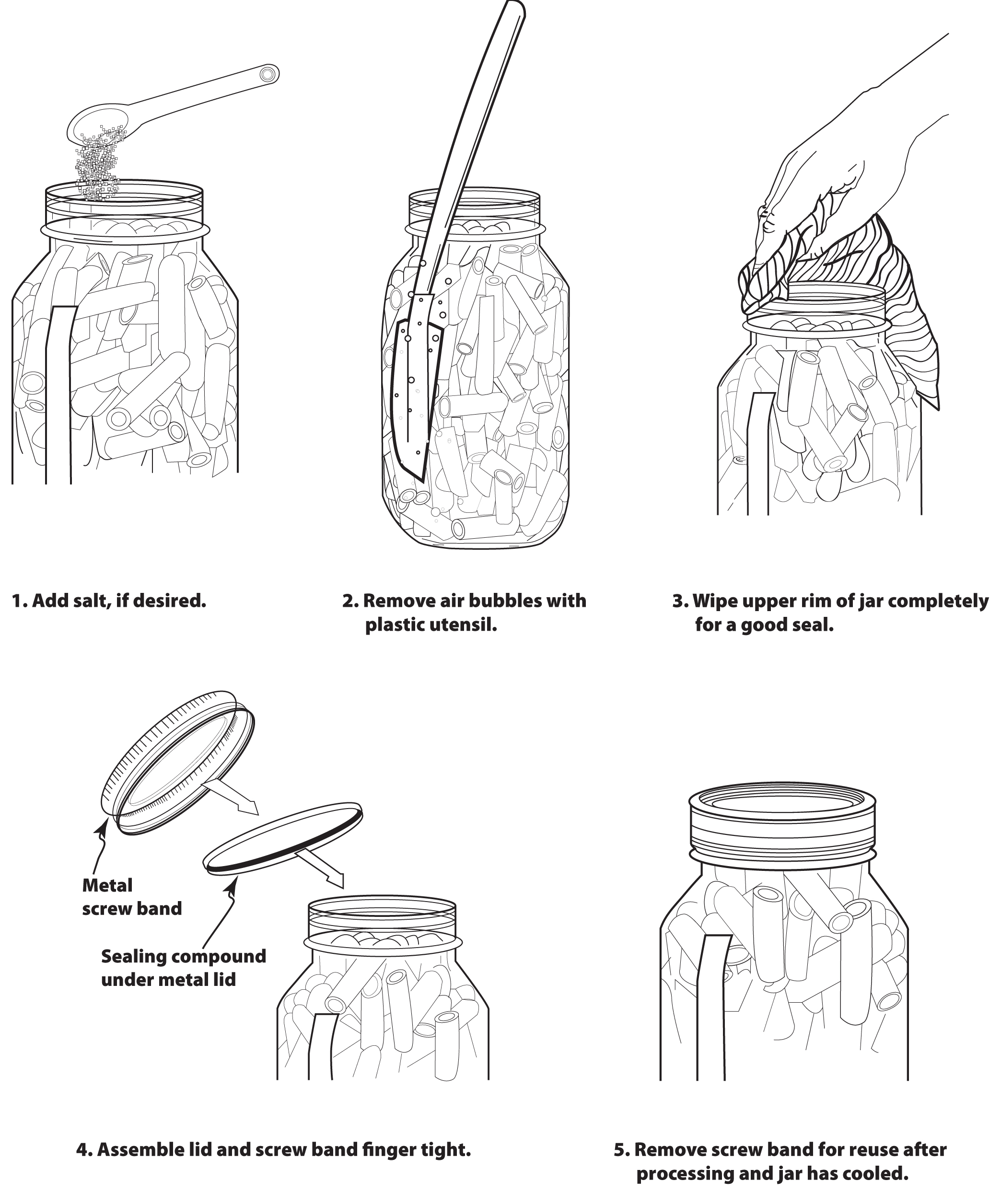
Figure 1. Procedure for filling canning jars before processing (illustration adapted from USDA, 2009, for New Mexico State University by Susan B. Portillo).
See Figure 2 illustrating these steps for pressure canner procedures.
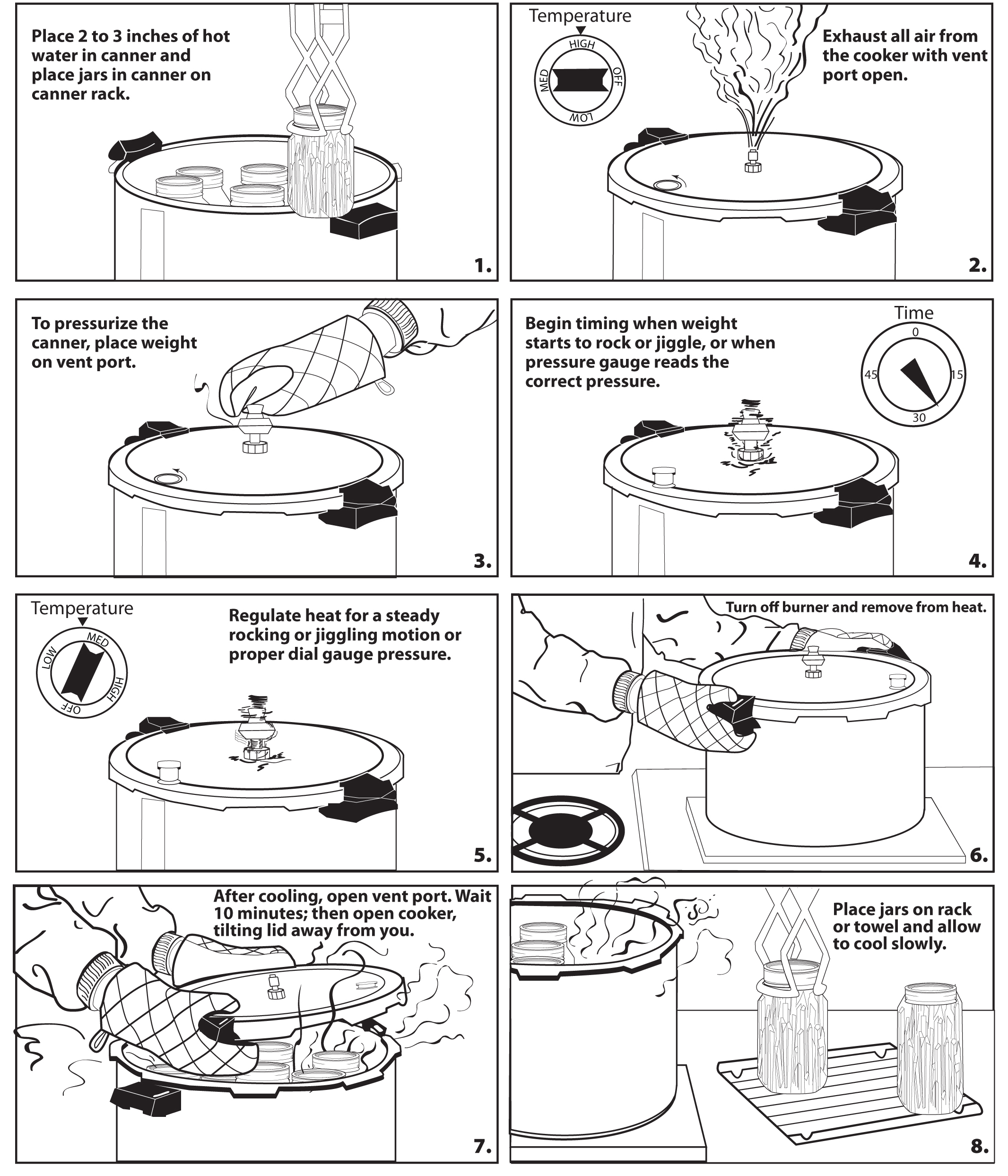
Figure 2. Procedure for processing canning jars using a pressure canner (illustration adapted from USDA, 2009, for New Mexico State University by Susan B. Portillo).
“Testing jar seals
After cooling jars for 12 to 24 hours, remove the screw bands and test seals with one of the following options:
Option 1. Press the middle of the lid with a finger or thumb. If the lid springs up when you release your finger, the lid is unsealed.
Option 2. Tap the lid with the bottom of a teaspoon. If it makes a dull sound, the lid is not sealed. If food is in contact with the underside of the lid, it will also cause a dull sound. If the jar is sealed correctly, it will make a ringing, high-pitched sound.
Option 3. Hold the jar at eye level and look across the lid. The lid should be concave (curved down slightly in the center). If center of the lid is either flat or bulging, it may not be sealed.” (p. I-25, USDA [2009]) See Figure 3 illustrating these steps for testing jar seals.
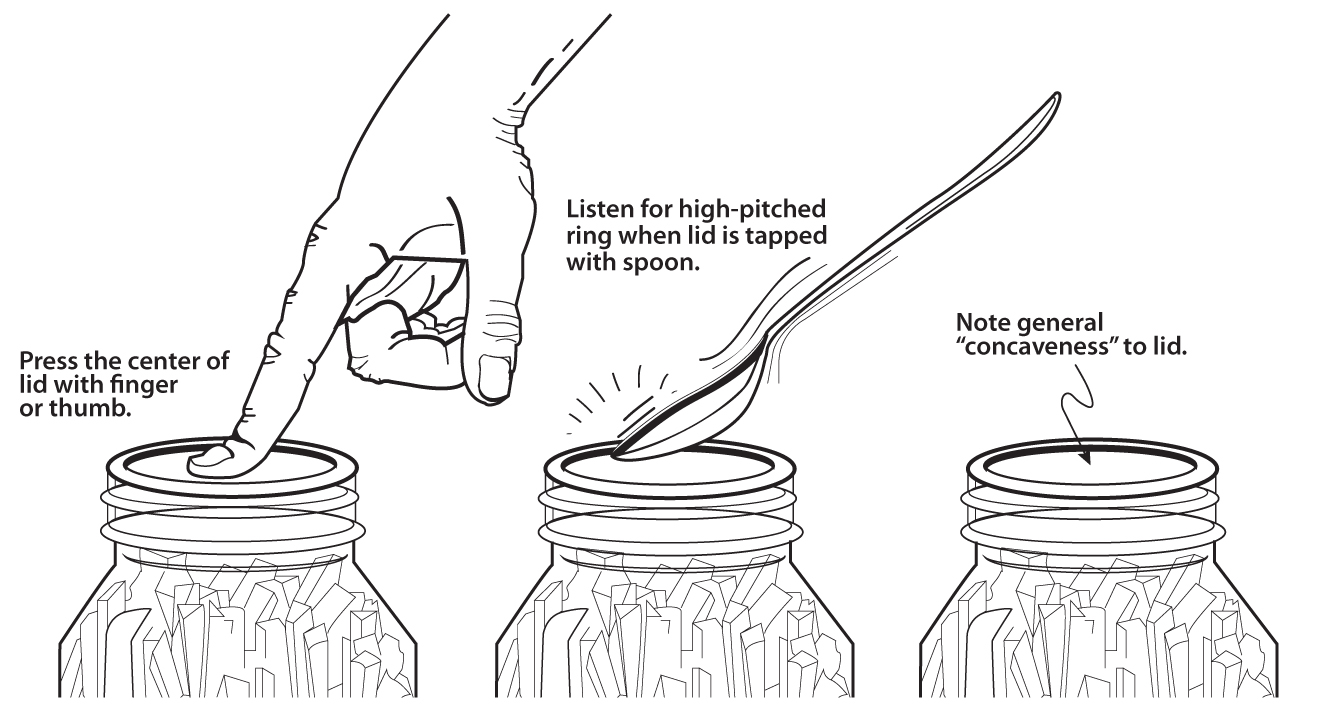
Figure 3. Procedure for testing jar seals after processing (illustration adapted from USDA, 2009, for New Mexico State University by Susan B. Portillo).
Reprocessing Unsealed Jars
Remove lids from unsealed jars and discard. Check the sealing surface of the jar for tiny nicks or cracks. If a jar has defects, discard it and replace it with another jar. If not, add a new lid and process for the same amount of time within 24 hours. Unsealed jars can be kept in the refrigerator and the food can be used within 3 to 4 days, or remove about an inch of the contents and freeze.
Storing Canned Food
Clean the outside of sealed, cooled jars with a damp towel dipped in a vinegar and water solution. Replace screw bands once they are completely dry, otherwise the bands will rust onto the lid and damage the lid and seal. Label with date and contents, including ingredients, and store in a cool (50–70°F), dark, dry place away from sun, light, or dampness. Tomato products are best if eaten within one year.
Accidental Freezing
Freezing may cause food in jars to spoil if the seal is broken. Freezing and thawing can cause food to soften and lose eating quality. Protect jars from freezing by wrapping them with layers of newspapers.
If Canned Food Spoils
Examine jars carefully before consuming. Check lids for a vacuum seal. NEVER taste food from an unsealed jar. Signs of food spoilage are streaks and dried food at the top of the jar, swollen lids, broken jar seals, rising air bubbles, and any unnatural color. Other indicators include bad or unnatural odor; spurting liquid; white, blue, green, or black mold; or foaming.
Dispose of any food you suspect of being spoiled. For safety, spoiled canned food and containers may need to be detoxified before disposal. Contact your county Extension office (https://aces.nmsu.edu/county) for detoxification instructions.
Elevation Adjustments
All communities in New Mexico are above sea level, varying from 3,000 to 10,000 feet in elevation, with differences even within a county.
Use Table 3 to determine the elevation of your community, and then select safe processing times for canning your vegetables. The boiling temperature of liquids is lower at higher elevations, and therefore food must be processed longer or at a higher pressure at high elevations. See Table 4 for pressure adjustments for different elevations.
|
Table 3. Elevations of Cities and Towns in New Mexico |
|||
|
City/Town |
Elevation (ft) |
City/Town |
Elevation (ft) |
|
Alamogordo |
4,350 |
Las Vegas |
6,450 |
|
Albuquerque |
5,000 |
Logan |
3,830 |
|
Artesia |
3,350 |
Lordsburg |
4,250 |
|
Aztec |
5,650 |
Los Alamos |
7,400 |
|
Bayard |
5,800 |
Los Ranchos de Albuquerque |
4,950 |
|
Belen |
4,800 |
Lovington |
3,900 |
|
Bernalillo |
5,050 |
Magdalena |
6,556 |
|
Bosque Farms |
4,864 |
Melrose |
4,599 |
|
Carlsbad |
3,100 |
Mora |
7,200 |
|
Carrizozo |
5,450 |
Mosquero |
5,550 |
|
Chama |
7,900 |
Mountainair |
6,500 |
|
Cimarron |
6,450 |
Portales |
4,010 |
|
Clayton |
5,050 |
Raton |
6,650 |
|
Cloudcroft |
8,650 |
Reserve |
5,749 |
|
Clovis |
4,300 |
Rio Rancho |
5,290 |
|
Columbus |
4,020 |
Roswell |
3,600 |
|
Corona |
6,664 |
Roy |
5,900 |
|
Corrales |
5,005 |
Ruidoso |
7,000 |
|
Cuba |
7,000 |
San Jon |
4,200 |
|
Deming |
4,300 |
Santa Fe |
7,000 |
|
Dexter |
3,500 |
Santa Rita |
6,300 |
|
Eagle Nest |
8,250 |
Santa Rosa |
4,600 |
|
Elida |
4,345 |
Silver City |
5,900 |
|
Española |
5,600 |
Socorro |
4,600 |
|
Estancia |
6,100 |
Springer |
5,800 |
|
Farmington |
5,400 |
Taos |
7,000 |
|
Fort Sumner |
4,050 |
Texico |
4,150 |
|
Gallup |
6,500 |
Tierra Amarilla |
7,460 |
|
Grants |
6,450 |
Truth or Consequences |
4,250 |
|
Hobbs |
3,650 |
Tucumcari |
4,100 |
|
Hurley |
5,700 |
Tularosa |
4,500 |
|
Jemez Springs |
6,200 |
Vaughn |
5,950 |
|
Las Cruces |
3,900 |
Wagon Mound |
6,200 |
|
Table 4. Elevation Adjustments for Pressure Canning |
|
|
Elevation |
Pounds of Pressure |
|
2,001–4,000 ft |
12 |
|
4,001–6,000 ft |
13 |
|
6,001–8,000 ft |
14 |
|
8,001–10,000 ft |
15 |
Reference
U.S. Department of Agriculture. 2009. Complete guide to home canning [Online]. Available at https://nchfp.uga.edu/publications/publications_usda.html
Home Canning of Vegetables
Note: The following instructions are for dial-gauge pressure canners. See Table 5 for general canning procedures for different vegetables. When using a pressure canner with a weighted gauge, use the 15-pound weight and the time periods given. See Figure 4 illustrating parts of a pressure canner.
|
Table 5. General Canning Procedures for Different Vegetables |
||||
|
Vegetable |
Pack |
Directions |
Jar size |
Processing time (minutes) |
|
Asparagus |
Hot |
Wash, trim off scales, snap off tough stems then wash again. Leave whole or cut into 1-inch pieces. Cover asparagus with boiling water. Boil 2 to 3 minutes. Fill jar loosely with hot asparagus, leaving a 1-inch headspace. Add boiling water, leaving a 1-inch headspace. Add salt if desired. Adjust lids and process. |
Pint |
30 |
|
Quart |
40 |
|||
|
Raw |
Fill jar with raw asparagus. Pack tightly without crushing. Add boiling water, leaving a 1-inch headspace. Add salt if desired. Adjust lids and process. |
Same |
||
|
Beans or peas (dry) |
Hot |
Sort dried beans or peas. Wash, place in a large pot, and cover with water. Boil 2 minutes, remove from heat, and allow to soak for 1 hour. Drain. Cover soaked beans with fresh water and boil 30 minutes. Fill jars with beans or peas. Add cooking water, leaving a 1-inch headspace. Add salt if desired. Adjust lids and process. |
Pint |
75 |
|
Quart |
90 |
|||
|
Beans (fresh green, Italian, snap, or wax)
|
Hot |
Wash beans and trim ends. Leave whole or cut into 1-inch pieces. Cover with boiling water. Boil 5 minutes. Fill jars loosely with beans. Add cooking water, leaving a 1-inch headspace. Add salt if desired. Adjust lids and process. |
Pint |
20 |
|
Quart |
25 |
|||
|
Raw |
Fill jars tightly with raw beans, leaving a 1-inch headspace. Add boiling water, leaving a 1-inch headspace. Add salt if desired. Adjust lids and process. |
Same |
||
|
Beets (whole, cubed, or sliced) |
Hot |
Trim off tops, leaving 1 inch of stems and roots to reduce bleeding. Scrub well. Cover with boiling water and boil until skins slip off (15 to 25 minutes, depending on size). Cool. Remove skins and trim off stems and roots. Leave baby beets whole. Cut medium or large beets into 1/2-inch cubes or slices. Fill jars with hot beets and fresh hot water, leaving a 1-inch headspace. Add salt if desired. Adjust lids and process. |
Pint |
30 |
|
Quart |
35 |
|||
|
Carrots (sliced or diced) |
Hot |
Wash, peel, and rewash carrots. Slice or dice. Cover with boiling water. Bring to boil and simmer 5 minutes. Fill jars with carrots, leaving a 1-inch headspace. Add boiling water or cooking liquid, leaving a 1-inch headspace. Add salt if desired. Adjust lids and process. |
Pint |
25 |
|
Quart |
30 |
|||
|
Raw |
Fill jars tightly with raw carrots, leaving a 1-inch headspace. Add hot water, leaving a 1-inch headspace. Add salt if desired. Adjust lids and process. |
Same |
||
|
Corn (cream style) |
Hot |
Select slightly immature ears of corn. Shuck, remove silk, and wash ears. Blanch ears for 4 minutes in boiling water. Cut corn from cob at about the center of kernel. Scrape ears with knife and add scrapings to kernels. Add 2 cups of water for each 4 cups of corn scrapings and heat to boiling. Fill only pints jars. Leave a 1-inch headspace. Add salt if desired. Adjust lids and process. |
Pint |
55 |
|
Corn (whole kernel) |
Hot |
Select slightly immature ears of sweet corn. Too immature corn tends to become brown. Shuck, remove silk, and wash ears. Blanch ears for 3 minutes in boiling water. Cut corn from cob at about three-fourths of kernel depth. Add 1 cup of water for each 4 cups of kernels and heat to boiling. Simmer 5 minutes. Fill jars with corn and cooking liquid, leaving a 1-inch headspace. Add salt if desired. Adjust lids and process. |
Quart |
85 |
|
Lima beans (fresh) |
Hot |
Shell beans and wash thoroughly. Cover beans with boiling water and return to boil. Fill jars loosely. Add boiling water, leaving a 1-inch headspace. Add salt if desired. Adjust lids and process. |
Pint |
40 |
|
Quart |
50 |
|||
|
Raw |
Fill jars loosely with raw beans and add boiling water to cover. Do not press or shake down. Leave 1-inch headspace for pints and 1 1/2-inch for quarts. Add salt if desired. Adjust lids and process. |
Same |
||
|
Mushrooms |
Hot |
Select domestic small- to medium-sized mushrooms with bright color, short stems, and unopened caps. Trim stems. Soak in cold water 10 minutes to remove dirt, then wash in clean water. Leave small mushrooms whole, but cut large ones. Cover with water in a saucepan and boil 5 minutes. Fill jars with hot mushrooms and add fresh hot water, leaving a 1-inch headspace. Add 1/8 teaspoon ascorbic acid powder for better color. Adjust lids and process. CAUTION: Do not can wild mushrooms. |
1/2 pint* |
45 |
|
Pint* |
45 |
|||
|
Okra |
Hot |
Select young, tender pods. Discard any pods with rust spots. Wash and trim pods. Cut into 1-inch pieces or leave whole. Cover with hot water, boil 2 minutes, and drain. Fill jars loosely with hot okra and cooking liquid, leaving a 1-inch headspace. Add salt if desired. Adjust lids and process. |
Pint |
25 |
|
Quart |
40 |
|||
|
Peas (shelled, green, English) |
Hot |
Select pods filled with young, tender, sweet seeds. Shell and wash peas. Cover with boiling water. Bring to boil and boil 2 minutes. Fill jars loosely with hot peas. Add cooking liquid, leaving a 1-inch headspace. Add salt if desired. Adjust lids and process. NOTE: Snow, sugar, and snap peas are not recommended because they can poorly. |
Pint |
40 |
|
Quart |
40 |
|||
|
Raw |
Fill jars loosely with raw peas and add boiling water, leaving a 1-inch headspace. Do not pack, shake, or press down. Add salt if desired. Adjust lids and process. |
Same |
||
|
Peppers (hot or sweet, including green chiles) |
Hot |
Select firm peppers. Wash, dry, and pierce each pepper. Peppers must be blanched in boiling water or blistered in an oven or broiler. Allow peppers to cool. Peel. Remove stems, cores, and seeds. Quarter large peppers. Small peppers can be flattened and left whole. Fill jars loosely with peppers. Add boiling water, leaving a 1-inch headspace. Add salt if desired. Adjust lids and process. CAUTION: Hot peppers may irritate hands. Use plastic gloves or avoid flesh of peppers. Keep hands away from eyes, face, and small children. |
1/2 pint* |
35 |
|
Pint* |
35 |
|||
|
Potatoes (white) |
Hot |
Select potatoes. (May become discolored if stored below 45°F.) Wash, peel, and cut into 1- to 2-inch cubes. Place in ascorbic acid solution. Drain. Boil 2 minutes if cubed, 10 minutes if whole. Discard water. Fill jars with hot potatoes and fresh water, leaving a 1-inch headspace. Add salt if desired. Adjust lids and process. |
Pint |
35 |
|
Quart |
40 |
|||
|
Pumpkin or winter squash |
Hot |
Select hard-rind pumpkins or squash. Stringless and small are better. Wash, remove seeds, peel, and cut into 1-inch cubes. Cover with water and boil 2 minutes. Fill jars with cubes and cooking liquid, leaving a 1-inch headspace. Add salt if desired. Adjust lids and process. CAUTION: Do not purée or mash. |
Pint |
55 |
|
Quart |
90 |
|||
|
Spinach or other greens |
Hot |
Can only freshly harvested, tender, evenly colored greens that are free of disease or insect damage. Cut away tough stems and midribs and wash small amounts at a time. Lift from water and repeat until water is clear and free of grit. Steam about 1 pound of spinach at a time in a blancher basket or cheesecloth bag for 3–5 minutes or until wilted. Loosely fill jars with hot spinach and cover with fresh boiling water, leaving a 1-inch headspace. Add salt if desired. Adjust lids and process. |
Pint |
70 |
|
Quart |
90 |
|||
|
Sweet potatoes (cubed) |
Hot |
Select small- or medium-sized sweet potatoes that are mature but not fibrous. Can them within 2 months of harvest. Wash potatoes, then boil 15–20 minutes. Remove skins. Cut into 1- to 2-inch chunks. Fill jars loosely with potatoes. Add boiling water, leaving a 1-inch headspace. Adjust lids and process. CAUTION: Do not dry pack, mash, or purée. |
Pint |
65 |
|
Quart |
90 |
|||
|
Vegetables (mixed) |
Hot |
Combine 6 cups each of sliced carrots, whole kernel corn, cut green beans, and shelled lima beans, and 4 cups each of chopped tomatoes and cubed or sliced zucchini. Wash and prepare vegetables as described elsewhere in this publication. Combine all vegetables in a large pot. Add water to cover and boil 5 minutes. Fill jars with hot vegetables and liquid, leaving a 1-inch headspace. Add salt if desired. Adjust lids and process. |
Pint |
75 |
|
Quart |
90 |
|||
|
*Fill only pint jars, not quarts. |
||||
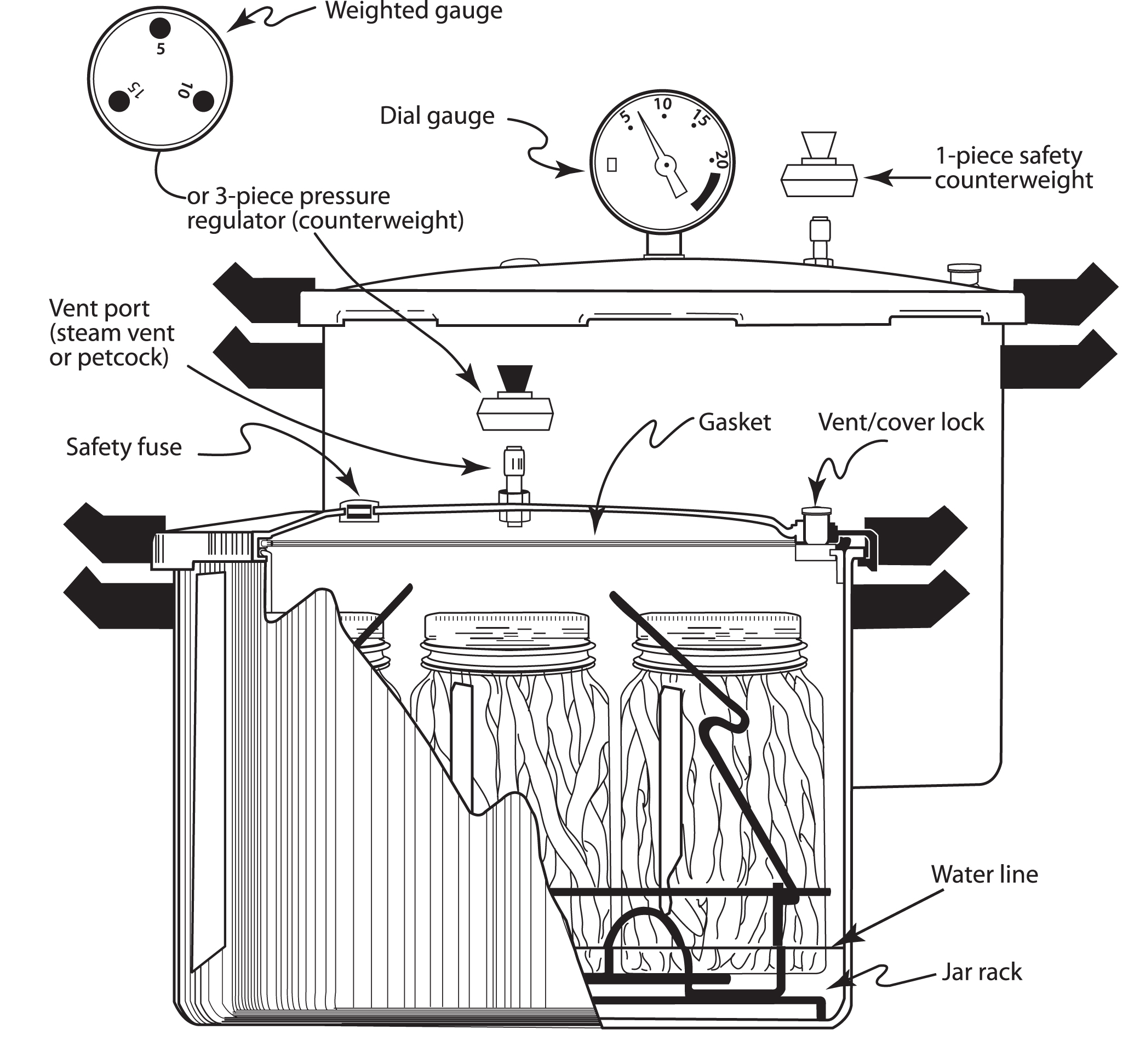
Figure 4. Parts of a pressure canner (illustration adapted from USDA, 2009, for New Mexico State University by Susan B. Portillo).
For Further Reading
Guide E-306: Preserving Tomatoes at Home
https://pubs.nmsu.edu/_e/E306/
Guide E-308: Canning Green Chile
https://pubs.nmsu.edu/_e/E308/
Guide E-319: Home Canning of Fruits
https://pubs.nmsu.edu/_e/E319/
|
Original author: Original author: Priscilla Grijalva, Extension Food and Nutrition Specialist. Subsequently revised by Martha Archuleta and Alice Jane Hendley, Extension Food and Nutrition Specialists. |

Nancy Flores is the Extension Food Technology Specialist in the Department of Extension Family and Consumer Sciences at NMSU. She earned her B.S. at NMSU, M.S. at the University of Missouri, and Ph.D. at Kansas State. Her Extension activities focus on food safety, food processing, and food technology.

Cindy Schlenker Davies is the County Program Director and Extension Home Economist at NMSU’s Bernalillo County Extension Office. She earned her B.S. at Eastern New Mexico University and her M.A. at NMSU. Her Extension and public outreach work focuses on food processing and preservation and food safety.
To find more resources for your business, home, or family, visit the College of Agricultural, Consumer and Environmental Sciences on the World Wide Web at pubs.nmsu.edu
Contents of publications may be freely reproduced for educational purposes. All other rights reserved. For permission to use publications for other purposes, contact pubs@nmsu.edu or the authors listed on the publication.
New Mexico State University is an equal opportunity/affirmative action employer and educator. NMSU and the U.S. Department of Agriculture cooperating.
Revised March 2016


